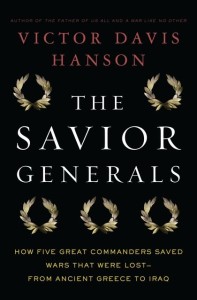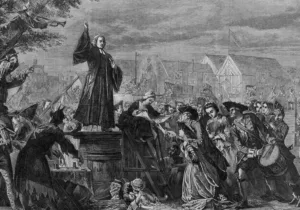Victor Davis Hanson, The Savior Generals: How Five Great Commanders Saved Wars That Were Lost – From Ancient Greece To Iraq
Bloomsbury Press, 2013
Shortly after 9/11, Mr. Rogers told children that whenever there was a disaster, natural or manmade, to head for the people who run to help and not for those running away. You know, Heroes.
Heroes are revealed in their times, but what makes heroes heroes in the first place are the determined choices that they make before there are even hints of crisis, choices which molded their very natures. We used to know and teach this trait. Our storytellers and writers knew this. It was taught around the fire and dinner table, from the pulpit and lectern. Today, though, it is an idea that is rejected and forgotten in this post- and post-post-modern age of passive Beta males and victims, and its purveyors of helpless, dependent milquetoasts.
This is the topic of classicist, historian, lecturer, professor, farmer, and writer Victor Davis Hanson’s book The Savior Generals. I am a fan of Hanson, of his online essays and commentary, his magazine columns and books. They are always worth seeking out, and I do. I picked up his The Savior Generals as soon as I could.
This book proposes that in times of crisis the right Man at the right time rises, does what needs to be done, and turns the tide of battle. These men and women are not the heroes of history; they are the heroes that make THE Heroes heroes. They are, as Hanson calls them, “firemen”.
“Firemen” is Hanson’s term for the men and women who run to a crisis, the fire, to help. They are the men and women who have determined to spend their lives in preparation for times that may never come. It is an idea not about bravery or cowardice, which are circumstantial. Firemen are who they are by will, integrity, and personal ethos.
Subtitled “How Five Great Commanders Saved Wars That Were Lost – From Ancient Greece To Iraq,” Hanson’s book first looks at the Athenian Themistocles and the Byzantine Belisarius. The last three examples are modern and American: General William Tecumseh Sherman of the Civil War, General Matthew Ridgway of the Korean War, and General David Petraeus of the Iraq War. Each leader burst forth into history when war was at its darkest, did their brief bit to save the day, and then faded back. They were “firemen.”
Each of these leaders saw beyond the immediate need. Themistocles believed in an idea that was worth fighting for, and he innovated to save and preserve it. Belisarius was a man of ethics, morality, and service. He understood battles and what comes after war. Sherman understood Total War, a war that is more than a series of battles, strategy, and allocation of armaments and resources. Turning the tide of war has to affect both sides. Sherman brought light to the North as he dimmed the will of the South. Ridgway had perspective. He studied and knew history, and he knew enough to climb above situational assumptions and see what was really going on. He saw a way out and knew how to instill courage. In Hanson’s telling, Petraeus is a distillation of the previous four. Time will tell.
At this book’s writing, Iraq is not a done deal. Here, now, in the thick of it, information is ephemeral, coming piecemeal, furiously spun by the media and commentators and then immediately replaced with more of the same. Hanson brings the historian’s distance and reminds us that understanding will come later with clarity and perspective.
I’ve read The Savior Generals twice. My first time was a much-enjoyed quick afternoon read, with Hanson’s firemen illustrating my concept of hero. When I reread it months later, looking for more meat, I was somewhat disappointed.
My disappointment is in the lack of information and focus. It is a work that would have benefited from an editor, a “fireman” of Hanson’s own to rise up and keep him on task, to keep him disciplined to say what he promised to say, working to tighten each paragraph and chapter, and the whole. All this information needs discipline and focus. Also, there is not enough of a clear and overarching narrative tying it all together, explaining why it matters. These are gripping stories not told as grippingly as they need to be with the brio, drama, and the derring-do inherent in each. 250 pages is short but should have been enough. The problem isn’t space; the problem is what is done with the space given.
This is not Hanson’s best work. It is not a bad book. I am glad that I bought it, and have it, but for me it is a tool directing me to further reading and research. The notes, bibliography and index are seductive, and I have succumbed to their pleasures happily. It is a fine book, though I wanted and want more.
Mike Scoggin lives, writes, edits and illustrates in the Pacific Northwest
Photo Credit: U.S. Navy. Damage controlmen practice firefighting techniques during a simulated fire in the incinerator room aboard the Nimitz-class aircraft carrier USS George Washington (CVN 73) as part of Talisman Sabre 2015 (TS15) exercise in the Timor Sea on July 9, 2015.







 Sponsor a student for Christianity & National Security 2024
Sponsor a student for Christianity & National Security 2024